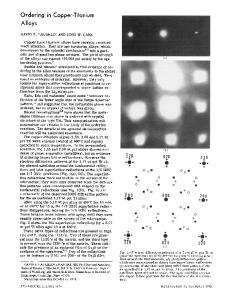Ordering transformation and spinodal decomposition in Au-Ni alloys
- PDF / 1,036,543 Bytes
- 10 Pages / 612 x 792 pts (letter) Page_size
- 88 Downloads / 381 Views
I.
INTRODUCTION
THE purpose of this study was to find a previously predicted transient ordering phenomenon within a disordered miscibility gap. Theoretical calculations by Zunger and coworkers[1–4] predicted the possibility of the occurrence of metastable long-range–order (LRO) phases within a disordered miscibility gap. Recent computer simulations also provided a similar prediction. Chen and Khachaturyan,[5] using a generic two-dimensional square lattice numerical simulation and assuming a pair interaction model, demonstrated that, during an isostructural decomposition of a disordered phase into a mixture of two disordered phases, as typically shown by a miscibility gap, it was possible to form one or more transient (virtual) ordered phases prior to the formation of the two equilibrium disordered phases. Their simulation was based upon the mean-field microscopic kinetic theory developed by Khachaturyan.[6,7] Reinhard and Turchi,[8] using a Monte Carlo simulation based on a first-principle electronic structure calculation, also demonstrated that transient B32 ordering could take place before the separation of a bcc matrix of a Ti50V50 alloy into Ti- and V-rich disordered bcc phases. These calculation and simulation results are significant to the theories of phase stability and phase transformations, because they challenge a widely accepted concept that only atomic clustering (no ordering) could occur within a disordered miscibility gap. However, no convincing evidence in bulk alloys has yet been found for the appearance of transient LRO states within a disordered miscibility gap. Au-Ni is a good alloy
JI-CHENG ZHAO, formerly Graduate Student, Department of Materials Science and Engineering, Lehigh University, is Staff Materials Scientist, General Electric Corporate Research and Development, Schenectady, NY 12301. MICHAEL R. NOTIS, Professor, is with the Department of Materials Science and Engineering, Lehigh University, Bethlehem, PA 18015. Manuscript submitted June 30, 1998. METALLURGICAL AND MATERIALS TRANSACTIONS A
system to test for the existence of this transient ordering phenomenon. The Au-Ni system has been a testing ground for theories of phase stability.[9] Theoretical study on the phase stability of the Au-Ni system has been extensive, and a critical review of literature results and a state-of-the-art calculation can be found in Wolverton and Zunger.[9] This most recent study is in agreement with the majority of previous theoretical studies that, for the fcc phase, the elastic (size mismatch) contribution to the heating of mixing (DHm) is a large positive value favoring clustering, and the chemical contribution to DHm is a smaller negative value favoring ordering. The total (net) DHm is still a small positive value, in agreement with the results experimentally evaluated by Wu and Cohen.[10] For the ordered structures, Lu et al.[11] and Lu and Zunger[12] defined an ordering energy of dEord 5 DHF(sx) 2 DHmix(x); where DHF(sx) is the formation enthalpy of an ordered compound of structure s, and DHmix(x) is
Data Loading...









